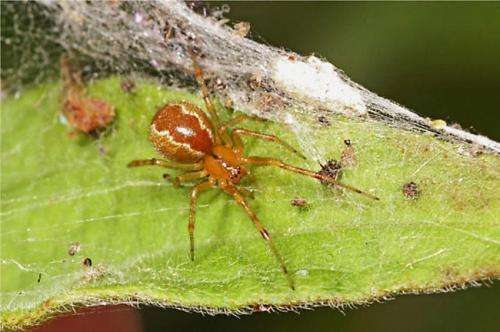June 17, 2014 report
Study shows social comb-footed spiders have two distinct types of personalities

Bob Yirka
news contributor

(Â鶹ÒùÔº) —A trio of researchers has found that a type of social arachnid: the comb-footed spider (Anelosimus studiosus) which lives in colonies, has female members that exhibit one of two types of behavior: aggressive or docile. In their paper published in Proceedings of the National Academy of Sciences, Colin Wright and Jonathan Pruitt of the University of Pittsburgh and C. Tate Holbrook of College of Coastal Georgia describe a study they undertook of A. studiosus and the unique behavior patterns they observed.
The 5 to 8 mm long comb-footed spider lives in both North and South America and unlike most spiders lives socially—in colonies with about six to eight members. All of the spiders participate in building nests, capturing prey, laying eggs and caring for young. But not all of them do all of those jobs equally well the researchers found.
Scientists have over time come to learn of different social structures among insects and animals in general—with insects, when different members have different jobs, they tend to have different body types. That does not appear to be the case with arachnids, as female comb-footed spiders all look alike. Also, prior research had found that some colony members appeared to be lazier than others, with some seeming to do little work at all. But when researchers removed them from a colony, the whole colony seemed to suffer as a result, indicating they did something important. To find out what that might be, the researchers captured some specimens in the wild and brought them back to their lab where the spiders were divided by what were viewed as personality types—those that appeared aggressive and those that were more docile. Colonies of each type were started and then monitored to see what might happen. All in all, the researchers noted the behavior of 141 aggressive and 148 docile females and how well they performed when engaged in various tasks (parental care, colony defense, prey capture and web repair).
Study of the spiders revealed the true nature of the two types—the aggressive spiders were more engaged in building a web, dealing with intruders and capturing prey. The docile members, on the other hand, tended to be much better at taking care of eggs and newly hatched spiders, proving they're not just freeloaders—instead they fill a very important social role. How the different spiders wind up with different personalities is still a mystery.
Written for you by our author —this article is the result of careful human work. We rely on readers like you to keep independent science journalism alive. If this reporting matters to you, please consider a (especially monthly). You'll get an ad-free account as a thank-you.
More information: Animal personality aligns task specialization and task proficiency in a spider society, Colin M. Wright, PNAS,
Abstract
Classic theory on division of labor implicitly assumes that task specialists are more proficient at their jobs than generalists and specialists in other tasks; however, recent data suggest that this might not hold for societies that lack discrete worker polymorphisms, which constitute the vast majority of animal societies. The facultatively social spider Anelosimus studiosus lacks castes, but females exhibit either a "docile" or "aggressive" phenotype. Here we observed the propensity of individual females of either phenotype to perform various tasks (i.e., prey capture, web building, parental care, and colony defense) in mixed-phenotype colonies. We then measured the performance outcomes of singleton individuals of either phenotype at each task to determine their proficiencies. Aggressive females participated more in prey capture, web building, and colony defense, whereas docile females engaged more in parental care. In staged trials, aggressive individuals were more effective at capturing prey, constructing webs, and defending the colony, whereas docile females were more effective at rearing large quantities of brood. Thus, individuals' propensity to perform tasks and their task proficiencies appear to be adaptively aligned in this system. Moreover, because the docile/aggressive phenotypes are heritable, these data suggest that within-colony variation is maintained because of advantages gleaned by division of labor.
Journal information: Proceedings of the National Academy of Sciences
© 2014 Â鶹ÒùÔº




















